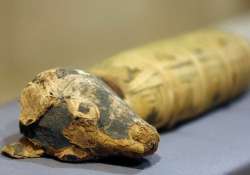Millions of mummified dog remains found in Egypt
London: For centuries, dogs have been humans' loyal companions and in ancient Egypt, they served as bridges to the afterlife, with the hope that they would intercede with the God Anubis on their owner's behalf.But

London: For centuries, dogs have been humans' loyal companions and in ancient Egypt, they served as bridges to the afterlife, with the hope that they would intercede with the God Anubis on their owner's behalf.
But only now is it becoming known the extent to which dogs served this role - 8 million times over, CNN reported.
That is the number of dead animals, most of them dogs, estimated to have laid in the catacombs of Anubis around Saqqara, one of Egypt's most historic and oft-visited sites, according to a group of British researchers.
While such mass burials are not unprecedented, given the numerous animal cults of ancient Egypt, this one's scale makes it unique.
"We're very pleased and somewhat surprised by the results," the project's director Paul Nicholson from Cardiff University's School of History, Archaeology and Religion said on Saturday.
"We hadn't expected that there would be so many animals, and it opens up a new series of questions."
One question that experts can at least partially answer is why an Egyptian might have brought an animal, dead or alive, to such a place.
A dog, especially, would be a good fit because it might then interact with Anubis, an ancient Egyptian God of the dead, depicted with the body of a man and head of a dog or, its close relative, a jackal.
"The important thing was to provide a representation of the God with a fitting burial," Nicholson said.
"It's not some sort of blood sacrifice. It's a religious act that's done for the best possible motive."
The animal's owner would hope that, by doing this, "some good will come to you", the Wales-based Egyptologist said.
"Maybe you're hoping that the animal will help someone in your family who has died recently (so that) Anubis will take care of that (relative)."
Just as Egyptians' view of Anubis, and dogs, has been common knowledge for some time, so too have the dog catacombs of Anubis. This includes a map from 1897 that shows their location clearly marked.
Still, most of the focus was on temples outside the catacomb. Until, that is, Nicholson's team -- with the support and help from Egypt's Supreme Council of Antiquities and sponsorship from National Geographic - began working on the Saqqara site around 2009 and began exploring deep inside.
They found a series of unadorned tunnels, in some cases filled with animal remains and in other cases cleared out. (Nicholson speculated that some may have been taken out for use in fertilisers, as has been done with other animal remains.)
Those that they found were mummified and wrapped in bandages, including some with a resin applied.
One should not imagine an ornate King Tut, though: They were likely stacked on top of each other and survived very badly, Nicholson said.
To estimate how many there are, the team took a sample and extrapolated from there how many likely filled up the catacomb.
One reason the number is so high is because many of the animals were very small; while there were some who were mature and likely had full lives. Nicholson speculated that some were "being especially bred for the cult".
The catacombs are believed to date from between roughly 750 to 30 BC, up to the time Egypt's society was interacting more and more with those of Europe, including ancient Greece and Rome.
A summary of the Cardiff team's findings was published this week in the journal Antiquity.